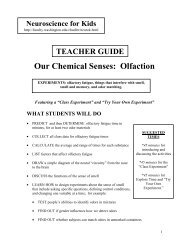Ernst Heinrich Haeckel (1834-1919) Influential German evolutionist ...
Ernst Heinrich Haeckel (1834-1919) Influential German evolutionist ...
Ernst Heinrich Haeckel (1834-1919) Influential German evolutionist ...
You also want an ePaper? Increase the reach of your titles
YUMPU automatically turns print PDFs into web optimized ePapers that Google loves.
<strong>Ernst</strong> <strong>Heinrich</strong> <strong>Haeckel</strong> (<strong>1834</strong>-<strong>1919</strong>)<br />
<strong>Influential</strong> <strong>German</strong><br />
<strong>evolutionist</strong>, morphologist,<br />
and developmental biologist.<br />
He argued that "ontogeny<br />
recapitulates phylogeny"<br />
and therefore that<br />
phylogeny should be<br />
reconstructed on the sole<br />
basis of ontogeny.
Wilhelm Roux (1850-1924)<br />
“….conclusions drawn from the<br />
investigation of individual<br />
development throw light on the<br />
phylogenetic processes.”
Richard Owen (1804-1892)
Charles Darwin (1809 –1882)<br />
“Unity of Type” vs. “ Conditions of Existence”<br />
“Common ancestor” vs. “ Descent with modification”
Figure 23.1(1) Relationships among Phyla
The search for the Urbilaterian ancestor<br />
Sean Carroll 1997<br />
—“paleonotology without fossils”<br />
—find homologous genes that are performing the same functions<br />
in both a deuterostome and a proteostome.<br />
Examples:<br />
1. Pax6 protein in eye development;<br />
2.tinman/Nkx2-5 in heart formation;<br />
3.transcription factor in head formation.<br />
4. anterior-posterior polarity based on Hox gene expression.
Extopic expression of Pax6<br />
induce eye formation
Figure 23.2 Expression of Regulatory Transcription Factors in Drosophila and in<br />
Vertebrates Along the Anterior-Posterior Axis
Figure 9.28 Homeotic Gene Expression in Drosophila
Hox genes: Descent with modification<br />
Slack et al (1993) - Hox gene expression pattern defines the development of all<br />
animals and that that pattern of Hox gene expression is constant for all phyla.<br />
Ways of modification:<br />
1. Changes in the Hox protein responsive elements of down stream genes;<br />
ex: fly’s halteres & butterfly’s hindwings; Ultrabithorax (Ubx);<br />
2. Changes in Hox gene transcription patterns within a region of the body;<br />
ex: abdominal prolegs in caterpillars; Distal-less (Dll)<br />
3. Changes in a Hox gene that give its protein new properties;<br />
ex: why arthropods varies in the numbers of legs?<br />
Ubx and Dll interaction is changed in the insect group.<br />
4. Changes in Hox gene transcription patterns between regions of the body;<br />
Ubx and abdA interaction in determine formation of locomoter limbs and<br />
feeding appendages.<br />
5. Changes in the number of Hox genes;<br />
**mutation in the Hox gene can produce “Atavistic” condition—the organism<br />
resembles an earlier evolutionary stage.
Figure 23.3 Differences in Larval and Adult Morphology Due to Hox Gene Differences
Figure 9.29 A Four-winged Fruit Fly Constructed by Putting Together Three<br />
Mutations in cis Regulators of the Ultrabithorax Gene
Figure 23.4 Distal-Less Gene Expression in the Larva of the Buckeye Butterfly, Precis
Figure 23.5(1) “Holes” in the Expression of abdA and Ubx in the Abdomen<br />
of the Larval Butterfly Precis
Figure 23.5(2) “Holes” in the Expression of abdA And Ubx in the Abdomen<br />
of the Larval Butterfly Precis
Figure 23.6(1) Changes in the Ultrabithorax Protein Associated with the Insect Clade
Figure 23.7(1) Hox<br />
Gene Expression and<br />
Morphological<br />
Change in<br />
Crustaceans
Figure 23.8 Schematic Representation of the Expression of Ubx and abdA (Green) in the<br />
Thoracic Segments of Different Types of Crustaceans
Figure 23.11 Postulated Ancestry of the Hox Genes From a Hypothetical Ancestor
Figure 23.10 Representation of Skeletal Elements:<br />
exmple of atavistism
Figure 23.13 Three Modifications of the Wnt Pathway<br />
Homologous pathways of development
Figure 23.15 Homology of Signaling Pathways in the Formation of the Anterior-Posterior<br />
Axes in Drosophila and Chick Appendages
Figure 23.16 Deep Homology of the Limbs
Figure 23.17 Allometry and Modularity in the Vertebrate Eye
Modularity<br />
Modularity allows three processes to alter development:<br />
(1) Dissociation:<br />
Heterochrony: shift in the relative timing of two developmental<br />
process<br />
ex: 1. eye development in reptile;<br />
2. larval stage in salamanders;<br />
Allometry: different part of the organism to develop in different rate;<br />
important in forming variant body plans within a phylum<br />
ex: toes of horse;<br />
(2) Duplication and divergence<br />
(3) Cooption: one gene for multiple function.<br />
ex: 1. engrailed and distal-less to form eyespot in butterfly wing<br />
2. jaw part become middle ear in mammals
Figure 23.18 Heterochrony in Bolitoglossa Can Create a Tree-Climbing Salamander
Figure 23.19 Allometric Growth in the Whale Head
Figure 23.20 Co-Option of Signal Transduction Pathways in the Formation<br />
of Butterfly Eyespots
Figure 23.21(1) Evolution of the Mammalian Middle Ear Bones From the Reptilian Jaw
Figure 23.21(2) Evolution of the Mammalian Middle Ear Bones From the Reptilian Jaw
Generation of evolutionary novelty<br />
Accumulation of small genetic changes<br />
OR<br />
Combining existing part in new ways rather than creating new parts<br />
(Francois Jacob, 1977)
Figure 23.22 Regulation of Chick Limb Apoptosis by BMPs
Figure 23.23(1) Expression Patterns of BMP2 and Shh in Feathers and Scales
Figure 23.23(2) Expression Patterns of BMP2 and Shh in Feathers and Scales
Figure 23.24 GIS Analysis of Gene Activity in the Formation of the First Set<br />
of Cusps in Mouse and Vole Molars
Figure 23.25(1) Basic Model for Cusp Development in Mice and Voles
Figure 23.25(2) Basic Model for Cusp Development in Mice and Voles
Figure 23.26 Neural Crest Cell Migration Patterns in Lampreys and Gnathostomes
Developmental constraints<br />
1. physical constrains<br />
2. morphogenetic constraints<br />
--reaction-diffusion model to explain limb formation.<br />
3. phyletic constraints<br />
Gould and Lewontin, 1979”once a structure comes to be generated by<br />
inductive interactions, it is difficult to start over again.”<br />
--the phylotypic stage of embryo development<br />
** Cannalization:<br />
buffering capacity of organism;<br />
new mutations do not alter development;<br />
through gene redundancy.
Figure 23.27 Relationship Between Cell Number and Number of Digits in Salamanders
Figure 23.28 Mechanism for the Bottleneck at the Pharyngula Stage<br />
of Vertebrate Development
Figure 23.30 A Newly Emerging Evolutionary Synthesis
















